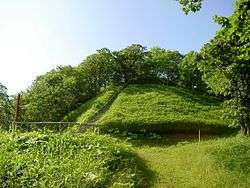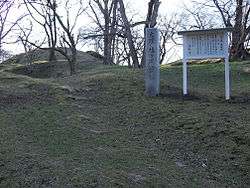Chashi

Chashi (チャシ also 砦) is the Japanese term for the hilltop fortifications of the Ainu. The word is of Ainu origin, from casi, which means palisade or palisaded compound; a rival theory relates the term to cas.[1][2] Over 520 chashi have been identified in Hokkaidō, mostly in the eastern regions of the island; others are known from southern Sakhalin and the Kurils; similar phenomena such as the ostrogu of Kamchatka and the gorodische of northeast Asia may have developed independently.[3][4] A few, including the Tōya casi of present-day Kushiro, date to the Muromachi period; the remainder date largely to the early seventeenth century.[1] As such their construction may be related to increased competition for resources as a result of "intensification of trade" with the Japanese.[1]
Form
The early Dutch explorer Maarten Gerritsz Vries described the chashi he encountered in eastern Hokkaidō in 1643:[3]
These forts were made as follows: on the mountain on which they were placed was a small road steep to climb, and round on the four sides palisades were placed of the height … of 1½ man's length; within this stood two or three houses. There were large fir doors in the palisades with strong clamps; when they were closed, two stout bars were passed through the clamps and thus fastened to them. At the two corners of these … palisades, a high scaffolding is made of fir planks, for a lookout.
Competition for resources

In 1604 Tokugawa Ieyasu granted exclusive trading rights with the Ainu to the Matsumae clan; lacking an agricultural base, the domain was dependent on trade; the Ainu in turn became increasingly dependent upon Japanese commodities and prestige goods.[1][5] Excavated chashi have revealed Japanese lacquerware, ceramics, ironware, and swords, as well as beads perhaps from Sakhalin; consumables included rice, sake, and tobacco.[1] In return the Ainu traded products derived from bird, beast, and fish; plants and medicines; and goods imported via Sakhalin.[1] However, "the market culture of the trading post … destroy[ed] the ecological balance … [through] overhunting and overfishing".[1] By the end of the following century, the depletion of natural stocks resulted in famine.[1] Furthermore, "competition over animals and fisheries was at the heart of most Ainu conflicts".[1]
Shakushain's Revolt
The Ezo hōki (蝦夷蜂起 Ezo Uprising) and Tsugaru ittōshi (津軽一統志 Tsugaru Unification Record) recount the internecine conflict of 1668/9, which culminated in massacres of the Japanese, military intervention, and subjugation, in what is known as Shakushain's Revolt.[1] According to the Ezo hōki, regional influence among the Ainu was based on "good land", "many utensils", charismatic authority, and physical strength.[1] In 1668, disputes over deer, bear cubs, and a live crane lead to the Hae elder Chikunashi and his mother burning down the Shibuchari casi and killing the escapees.[1] In response Shakushain sent the Urakawa Ainu to attack the Atsubetsu casi; driven off by musket fire they returned in force and captured it, after many of its defenders had left in search of food.[1] The conflict escalated the following year into fighting with the Japanese; after his final surrender, Shukushain was killed and the Shibuchari casi again burned to the ground.[1]
Known chashi

Among the approximately five hundred and thirty chashi identified by archaeologists, the sites of eight have been designated national Historic Sites: the Otafunbe chashi;[6] Shibechari River chashi and Appetsu chashi;[7] Moshiriya chashi;[8] Yukuepira chashi;[9] Katsuragaoka chashi;[10] Nemuro Peninsula chashi;[11] and Tsurugataicharanke chashi.[12] Others known include the Arashiyama casi, Harutoru casi, Onibishi's casi, Sarushina casi, Sashirui casi, Setanai casi, and Uraike casi.[1] Although there are nineteen chashi on the Shiretoko Peninsula, it is inscribed as a Natural rather than a mixed Natural and Cultural UNESCO World Heritage Site.[13][14]
Functions
In addition to providing for defence against rival Ainu, chashi functioned as centres for gatherings and rituals.[1][15] They also served as "visible symbols of chiefdom power".[1] According to narrative uepeker or folktales, Akkeshi and Nemuro Ainu attacked the Uraike casi in the hope of "fine treasure"; other chashi were attacked by hungry Ainu looking for venison and dried salmon.[1]
See also
References
- 1 2 3 4 5 6 7 8 9 10 11 12 13 14 15 16 17 18 Walker, Brett L (2001). The Conquest of Ainu Lands: Ecology and Culture in Japanese Expansion, 1590-1800. University of California Press. pp. 36–8, 58–67, 93–4, 123–6. ISBN 0-520-22736-0.
- ↑ "Chashi". Japanese Architecture and Art Net Users System. Retrieved 21 June 2012.
- 1 2 Hudson, Mark (2000). Ruins of Identity: Ethnogenesis in the Japanese Islands. University of Hawaii Press. pp. 216–7. ISBN 978-0-824-82156-2.
- ↑ Ushiro Hiroshi. "Establishment process of Chashi and Fortified Settlement Sites in Northeast Asia and their environmental change". National Institute of Informatics. Retrieved 24 June 2012.
- ↑ Howell, David L (1995). Capitalism from Within: Economy, Society, and the State in a Japanese Fishery. University of California Press. pp. 27–35. ISBN 978-0-520-08629-6.
- ↑ "オタフンベチャシ跡" [Otafunbe Chashi Site] (in Japanese). Agency for Cultural Affairs. Retrieved 21 June 2012.
- ↑ "シベチャリ川流域チャシ跡群及びアッペツチャシ跡" [Shibechari River Chashi Site - Appetsu Chashi Site] (in Japanese). Agency for Cultural Affairs. Retrieved 21 June 2012.
- ↑ "モシリヤ砦跡" [Moshiriya Chashi Site] (in Japanese). Agency for Cultural Affairs. Retrieved 21 June 2012.
- ↑ "ユクエピラチャシ跡" [Yukuepira Chashi Site] (in Japanese). Agency for Cultural Affairs. Retrieved 21 June 2012.
- ↑ "桂ヶ岡砦跡" [Katsuragaoka Chashi Site] (in Japanese). Agency for Cultural Affairs. Retrieved 21 June 2012.
- ↑ "根室半島チャシ跡群" [Nemuro Peninsula Chashi Site] (in Japanese). Agency for Cultural Affairs. Retrieved 21 June 2012.
- ↑ "鶴ヶ岱チャランケ砦跡" [Tsurugataicharanke Chashi Site] (in Japanese). Agency for Cultural Affairs. Retrieved 21 June 2012.
- ↑ Kato Hirofumi. "World Heritage and Indigenous archaeology in Hokkaido Island" (PDF). Hokkaido University. Retrieved 24 June 2012.
- ↑ "Shiretoko". UNESCO. Retrieved 24 June 2012.
- ↑ Ushiro Hiroshi. "Systematic structure of protective settlements and Chashi (Fortes Ainu) found in the northern areas, and ethnic encounters". National Institute of Informatics. Retrieved 24 June 2012.